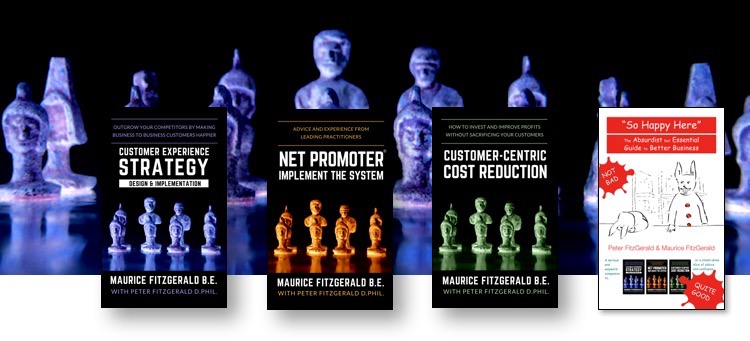#77 – The Ultimate Question? Invisible dragons, text analytics, response rates
 The ultimate question, the impossibility of proving something does not exist, text analytics, survey response rates and scores for hospitals, LinkedIn groups. Welcome to the 77th edition of my customer strategy newsletter. The five topics this week are:
Is ‘willingness to recommend’ really ‘The Ultimate Question’? In their book The Ultimate Question 2.0 Reichheld and Markey refer to the research first covered by Fred Reichheld in his landmark HBR paper The One Number You Need to Grow. The research was about what single question best predicts revenue growth. Such a question is referred to as ‘The Ultimate Question’. While most people remember the answer as “How likely are you to recommend company X to a colleague or friend?” that is an incomplete picture. Yes, the ‘Ultimate Question’ is indeed whatever single question best predicts revenue growth. And yes, the recommendation question is that question in most industries. It finished in first or second place in 11 of 14 industries among 40 questions tested. However, there are industries for which it did not finish on top. You can find full details by clicking on the link to the HBR article, and I want to mention that ‘overall satisfaction’ did not make it to the top for any industry. So, what does this mean if you are starting to implement the Net Promoter System? It means that you are best off starting with the recommendation question as your Ultimate Question. If you ask an additional question and compare its predictive value to the recommendation question you may get a surprise. If the second question is shown scientifically to be a better predictor, then that is what you should use. At the risk of being pedantic, it is not impossible that overall satisfaction could still be the Ultimate Question for your company. However, please ensure that all departments in your company use the same question, or communication will be impossible. Finally, some objectors to the recommendation question say, “I have come up with this composite metric that is a better predictor of market share.” That may well be the case. However, composite metrics, by definition, are not the answers to a single question. It’s impossible to prove that something does not matter to customers I was recently asked “But how do you know for certain that customers don’t want this?” My answer was that I could not prove they didn’t want it. I could only suggest that the science-based research that I carried out suggested that customers did not care about it. This type of discussion can be quite problematic for customer experience leaders who have strong-willed and outspoken senior leaders to deal with. The most difficult situations arise with managers who say they have built their entire careers in one way: “I trust nothing but my own instinct!!!” (If you are a customer experience leader and your manager does not trust science or scientists, you should probably look for a new job.) The challenge is that from a scientific perspective it is impossible to prove the absence of anything. I can state that there is a completely invisible small blue dragon hovering between you and the screen on which you are reading this. It is totally impossible for you to prove that this is not so. It is of course extremely unlikely. We see this communication challenge from time to time in customer experience. However, it is an increasing phenomenon in society as a whole. “Unless you can prove to me that GMOs (or perhaps Glyphosate, or vaccines) pose no risk at all on their own or in combination with any other chemical, they should not be allowed.” That’s a completely impossible task as absence of risk or of anything else can never be proven. Why is it so hard to persuade people to accept scientific consensus?
Our latest blog posts Two of the three below are new original content. The third is an edited chapter from one of our books. Older posts are still available on the blog page.
Notable customer experience items from other sites Thematic & Alyona Medelyan: Amazing article on text analytics This is without doubt the best article I have read about text analytics ever. Regular readers will know that I consider it to be the top technical challenge we face in customer research. We tend to send customers long feedback requests with lots of rating questions simply because we don’t yet trust text analytics. Please read the article. It will take you about ten minutes and I guarantee you will learn something new. Read it here. Business Broadway: The relationship between survey response rates and survey ratings It is always interesting to read well-structured research that produces opposite results to prior research. In this case, Bob Hayes wrote an article way back in 2012 that shows that the more people respond, the better the ratings. My own research at HP on NPS ratings and response rates showed the opposite, as people who really liked us seemed disproportionately likely to respond when we had low response rates. I wonder whether there is something specific to hospitals that mean that Bob’s results follow a similar but opposite logic. Could patients who were upset with their experience at a hospital be more likely to respond than those who were happy? Please let me know what you think. Read all about it here.
Looking forward I have spent / lost quite a bit of time over the last three weeks trying to persuade LinkedIn to reverse the changes they have made to Group management. I had a teleconference with representatives of the product team last week and they committed to reverse one of the changes, though with no date attached. That’s really not good enough. The 102,000 members of the Customer Experience Management group that I manage need better. Since the changes were implemented user interaction with new posts has dropped off a cliff. As I write this there are a total of two comments on the last 50 articles that have been posted. The tools I used to use to stimulate conversations and limit the appearance of irrelevant stuff have almost all disappeared. Disappointing. This means that I have to change my NPS status for LinkedIn Groups from Promoter to Detractor. I definitely would not recommend them, including my own group. On a more positive note, I am running a free one-hour webinar on NPS for the European arm of the Association of Field Service Managers this Thursday afternoon my time, so you should have heard about it if you are an AFSMI member. Here are links to all of our books on Amazon.com. Kindle versions are available in all stores. Print versions are available from the major stores only. Customer Experience Strategy – Design & Implementation Net Promoter – Implement the System Customer-centric Cost Reduction “So Happy Here”: The Absurdist but Essential Guide to Better Business (Color edition) “So Happy Here”: The Absurdist but Essential Guide to Better Business (Black & White edition) Please share this newsletter with your friends and colleagues and encourage them to sign up for it here. I have put links to past newsletters on the subscription page. Finally, please feel free to change or cancel your subscription using the link below. You can also email me, Maurice FitzGerald, at mfg@customerstrategy.net. |






